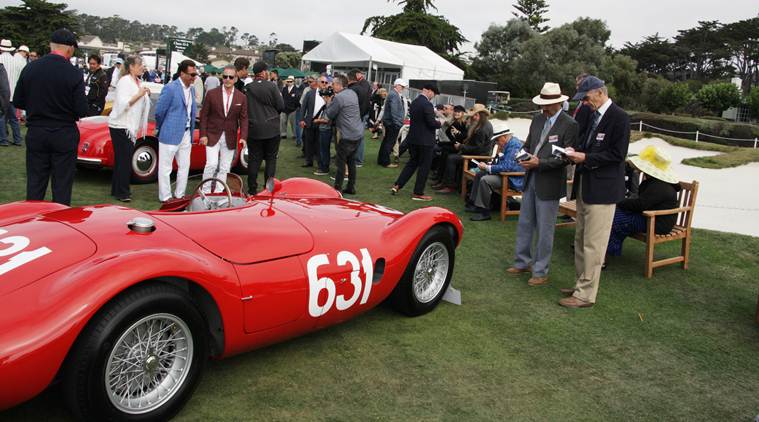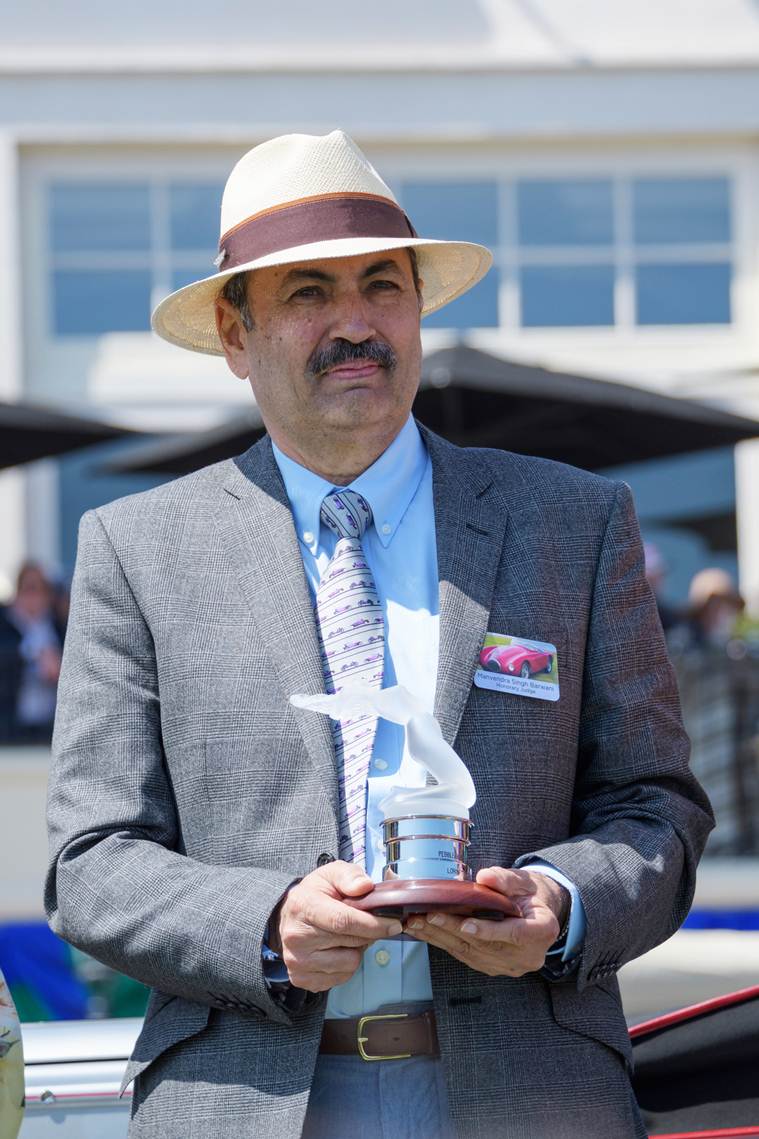- India
- International
Of Fine Vintage: Rana Manvendra Singh Barwani and his love for vintage cars
Indore’s Rana Manvendra Singh Barwani, who won this year’s Lorin Tryon Trophy at Pebble Beach Concours d’Elegance, US, has been restoring and promoting vintage cars for decades.
 Revving up: Rana Manvendra Singh Barwani (second from right) judging a vintage car in the rally last month in California. (Courtesy: Kimball Studios/Pebble Beach Concours d’Elegance)
Revving up: Rana Manvendra Singh Barwani (second from right) judging a vintage car in the rally last month in California. (Courtesy: Kimball Studios/Pebble Beach Concours d’Elegance)
When people first saw Rana Manvendra Singh Barwani tinkering with cars in a makeshift workshop in Indore in 1980, standing under a tree, his clothes dirty, they approached his father Rana Devi Singh to ask if he knew what his son was up to.
“Maharaj sahab, it doesn’t look good,’’ they would feebly complain. Devi Singh was the erstwhile Maharana of Barwani, an 11-gun salute state, whose rulers were descendants of the ruling dynasty of Udaipur.
Devi Singh did not intervene and let his son pursue what he liked doing. “My parents could have sent me to an elite school to become a lawyer, doctor or pilot. But they let me get my hands dirty on Indore’s streets,’’ says Barwani, 66, who won the prestigious Lorin Tryon Trophy at Pebble Beach Concours d’Elegance in California last month.
It’s one of the most important awards in the international vintage world and is given to a person who has made a significant contribution in the promotion of classic cars. Rana Manvendra Singh Barwani is a classic car historian and restorer, a hobby he has pursued for nearly 40 years.
The only Indian to have won the award and to start a classic-car restoration shop in 1985 in Indore, Barwani is an authority on vintage and classic cars in the country. He is also the only Indian to be invited to Pebble Beach as a judge since 2012, going there annually since, among 102 others to judge this competition that has 60 categories. There, he has been in the company of elite car designers, experts, Formula-One drivers, and leading car makers. The award was given to him for his restoration and promotional efforts. “I was surprised, actually shocked, when I got the award because I least expected it,’’ he says.

The first Pebble Beach Concours d’Elegance was conducted in 1950 and has grown to become the world’s premier celebration of vintage automobiles. As connoisseurs of beautiful and historic cars gather in admiration, Manvendra compares the event to the Oscars, calling it the crowning jewel of all concours world over. “Taking a car there is like winning a medal,” he says.
Researching the country’s automobile history and preserving old cars came easy to him. He admits being fortunate to have been born in a royal family that gave him an opportunity early on to learn from other erstwhile royals, about their collections, passion for and experiences with vintage cars. He also has a collection of automobile magazines from the erstwhile ruler of Wankaner, in Gujarat, which came handy in his research on royal cars.
Barwani remembers his father’s gripe against Western authors writing about the Indian royalty. “They had no idea of our history, religion and traditions,’’ he says. His father would often remark, “How dare this fellow write something like this?”.
 Rana Manvendra Singh Barwani holding the Lorin Tryon Trophy. (Courtesy: Kimball Studios/Pebble Beach Concours d’Elegance)
Rana Manvendra Singh Barwani holding the Lorin Tryon Trophy. (Courtesy: Kimball Studios/Pebble Beach Concours d’Elegance)
He wondered if this ignorance about India’s heritage influenced their perception of automobiles and started researching and cataloguing the cars, in 1972-73, according to their engines, chassis, colours and special features, etc. He collected 3,000 photographs and made his own library. These were used in the book, The Automobiles of the Maharajas (2003), which he collaborated with author Sharada Dwivedi. “She had a lot of archival material but no access to an automobile expert.’’
Barwani has many anecdotes to share. One such interesting fact is that nearly one-fifth of the 4,000-odd Rolls-Royce manufactured between 1912 and 1947 were sold in India. Of them, around 220 still survive, the rest have been shipped out of the country or sold in scrap.
He narrates a story about the ruler of Bharatpur who imported Rolls-Royce and used them to cart garbage to avenge an insult by a salesman who reportedly shooed him away from a Rolls-Royce showroom in London for wearing a dhoti. “He threw one (Rolls-Royce) from a mountain top to find out if they were really as sturdy as the maker claimed them to be,” he says.
Barwani says cars were also imported for religious purposes to replace chariots and were used to carry idols in processions. Such cars would have cloth upholstery, not leather, in keeping with the tradition of not hurting religious sentiments.
His elder brother’s Fiat was the first car he customised in his workshop. “It was so well received. Everybody was enamoured of it.’’ he says. Since then, he has restored about 300 cars.
After Independence, his parents moved from Barwani to Indore, about 170 km away, for the children’s education. Barwani was born there. They first lived in a rented accommodation before buying a big plot to build a house in the 1960s. In a corner of the Barwani House, as it is called, Barwani started his workshop before finding a suitable and bigger place. He still has the Rs1,500 compressor, from those days, that he had bought from the loan-money his mother had given him.
Barwani completed his schooling from Daly College and graduation in Arts from Christian College, both in Indore, before going to the US for a course in business management in automobile marketing from 1974 to 1977. He got a job in sales and marketing in Iran but says with relief that he chose not to go there, since the country was in the throes of the Iranian Revolution that year.
He has around 20 vintage cars but they are fairly modern in comparison to those that went to Pebble Beach last month. Nine cars from India featured in the category “Motor Cars of the Raj” that he helped the organisers curate.
Now he has drastically cut down on his restoration work and limits himself to providing expertise in judging and helping researchers and historians. “People around the world contact me if they have doubts about the provenance of cars, from auction houses or buyers,’’ he says.
The first international Cartier Concours d’Elegance show was held in Mumbai in 2008, once they heard about Barwani. And since then, he has been the curator of this biennial event. He credits himself for starting the concept of Indian heritage class — followed by many clubs in the country to feature Indian cars — the hobby, however, is treated as an “obscure cause”, he says. Ask him whether he drives vintage cars, and he says, “modern cars” always, quite matter-of-factly.
Apr 23: Latest News
- 01
- 02
- 03
- 04
- 05






































